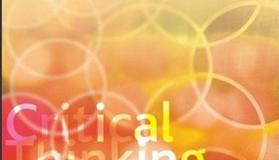Skill 5: Recognizing the Key Information in anArgument
Inmost circumstances, authors aim to persuade us to a particular point of viewbecause they believe in what they are saying. Authors may intentionally, orunintentionally, interpret information through the filter of their ownpolitical, religious or ideological perspectives. That doesn’t necessarily maketheir argument invalid, but it is often important to know their theoreticalposition in order to identify the influences on their line of reasoning.
Following is an example for isolating keyinformation in a passage in order to identify the argument.
Example:
①Pit’s End should become a site of major archaeological importance. ②Formerly, itwas believed that the three large granite stones found near the village weredeposited after the melting of glaciers at the end of the last ice age. ③Eleven newstones were unearthed during recent excavations. ④The area had beencovered in farmland. ⑤Aerial photography suggested that the area wasworthy of excavation. ⑥The layout of thefourteen stones suggests they were originally part of an unusual ovalformation. ⑦They are spaced evenly at approximately two meters,which suggest they were laid out by a former settlement, possibly for religiouspurposes. ⑧Geologists confirm they are unlikely to have beenlaid down by glacial or other natural causes. ⑨Tools unearthed there recently are amongst the oldest ever discovered inthis country, making them of significant interest. ⑩The dig has been funded by the national lottery.
Which sentences can be removed as backgroundinformation or explanations since they do not directly support the position?
Presenting key information (Lineof reasoning) in a visual way
Taking notes helps readers to capture keyinformation effectively in reading. Here graphic organizers are recommended toyou for isolating key information from other information.
A graphic organizer is a kind of visual aid to facilitate learning and instruction. Many types ofgraphic organizers can be usedfor leaning reading comprehension. For example, a story elements graphicorganizer can help students recognize and analyze the essential elements of astory, to help them understand the content and the theme. Also, the 5Ws chartcontains five sections with blank areas that students can fill in the detailsof the questions, what happened, when did it happen, why did it happen, wheredid it happen, and who was involved. In addition, the sequencing timeline,compare and contrast chart, fact and opinion chart, main idea, and detailschart are all effective means to help students improve their reading skills.
For isolation key information in an argument, youmay adopt typical mind-maps or flow charts indicating position, the line ofreasoning and conclusion. Since a line of reasoning is constructed with a setof propositions, to present them clearly, you are suggested to summarize eachproposition and its supporting details with only key works or short phrases.


Activity : Isolate the key information inthe following passages. And draw a relevant graphic summary for each.
Passage1:
①Satellite imaging has been used to match water temperature swirls drawn ona map of ocean currents made as long ago as 1539. ②The map wasproduced by a Swedish cartographer, Olaus Magnus. ③It had beenthought that the rounded swirls, located between pictures of serpents and seamonsters, were there for purely artistic reasons. ④However, thesize, shape and location of the swirls matches changes in water temperature tooclosely for this to be a coincidence. ⑤The map is likely tobe an accurate representation of the ocean eddy current found to the south andeast of Iceland. ⑥It is believed that the map-maker collected hisinformation from German mariners of the Hanseatic League.
Passage2:
①Major catastrophes, rather than graduate evolution, may be the main causeof change. ②Such a view did not seem plausible in the past as it was assumed that theprocess of the geological change took place in gradual way, just as it appearsto today. ③However, evidence now suggests that change can be rapid and extreme. ④Geologicalevidence indicates that an enormous meteor collided with the earth severalhundred million years ago, making most life- forms extinct. ⑤Geological science now attracts more funding than it did in the past. ⑥Archeological evidence suggests that sudden changes in the environmentbrought about the rapid collapse of ancient civilizations.
Passage3:
①The nature and origin of disease was unclear until relatively recently. ②At the end of the nineteenth century, Koch, a Prussian scientist,introduced a set of procedures now known as Koch’spostulates. ③He experimented with bacterial colonies cultivatedin the laboratory, made from the blood of dying cattle. ④When these cultures were injected into healthy live cattle, these alsocaught the same disease. ⑤At the time, these findings were astonishing. ⑥Koch had been able to provide proof to support the theory that disease wasspread by germs. ⑦He contributed oneof the most important methodological advances in the history of medicine.


